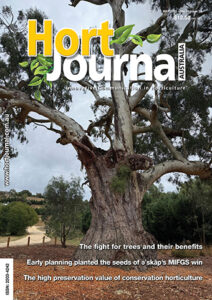
Landscaping the future
Speaking with designers and installers at the recent Melbourne International Flower and Garden Show (MIFGS) made me think about some of the challenges and issues they need to address when designing landscapes. The landscape philosophy is constantly evolving.
From climate change and urbanisation to social equity and technological innovation, landscape architects and designers are now focusing on creating spaces that not only look aesthetically pleasing but also regenerate ecosystems, promote well-being, and promote environmental resilience.
In many areas where damage has been caused for one reason or another, designers need to consider regenerative design to restore ecosystems as opposed to simply reducing the harm previously caused.
You would have read many of Michael Casey’s articles in Hort Journal over the years. He has discussed how green spaces are designed to capture carbon, mitigate climate change, and address water scarcity. Drought-tolerant plants, rain gardens, and stormwater systems are becoming integral to urban landscapes, helping to conserve water and enhance ecological health.
Biophilic design was evident in many of the designs at MIFGS, reconnecting people with nature. These designs included natural elements like green walls, trees, and natural-style water features, promoting mental and physical health. Not so long ago, most water features included a concrete ball with water rippling from the top, and the overflow was captured in a square trough. Today’s designs try to emulate natural streams with the inclusion of rocks or logs and surrounded by native plants, which creates a habitat for birds and wildlife – something you are likely to see on a bushwalk.
Urban forests and green roofs are commonplace, offering benefits like temperature regulation and improved air quality while combatting the urban heat island effect.
Technology is constantly changing and improving, with many architects and designers taking advantage of it. Digital tools allow for data-driven, precise designs, while IoT-enabled systems for irrigation, lighting, and environmental monitoring make landscapes more efficient and responsive. Augmented and virtual reality are also being used to visualise designs, giving clients and stakeholders a clear picture of the design before final decisions are made.
The changing landscape design philosophy includes social equity and inclusivity in public places with a growing focus on creating public spaces accessible to people of all abilities, ages, and backgrounds.
In response to climate change, landscape architects and designers incorporate nature-based designs, such as green roofs and urban wetlands, into city infrastructure, offering sustainable alternatives to traditional systems while enhancing biodiversity and improving ecological health. Another important trend is rewilding cities by reintroducing native species and creating wildlife habitats.
Urban agriculture and edible landscapes are becoming more common. Recently, I noticed a public structure in Sydney’s King’s Cross planted with flowering plants and herbs. By incorporating food-producing plants into urban environments, designers are strengthening the connection between people and food. I would love to see this on every street. Wouldn’t that be nice?
Landscape architecture in 2025 is about designing spaces that are not only beautiful but also resilient, regenerative, and inclusive, ultimately contributing to a more sustainable and equitable world. I was impressed with the designs for all of the above reasons.
I look forward to watching the landscape architecture space.
Enjoy the read
Karen Smith and your Hort Journal team
